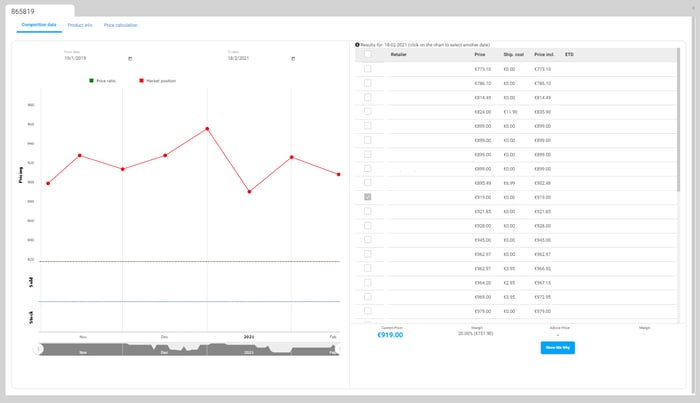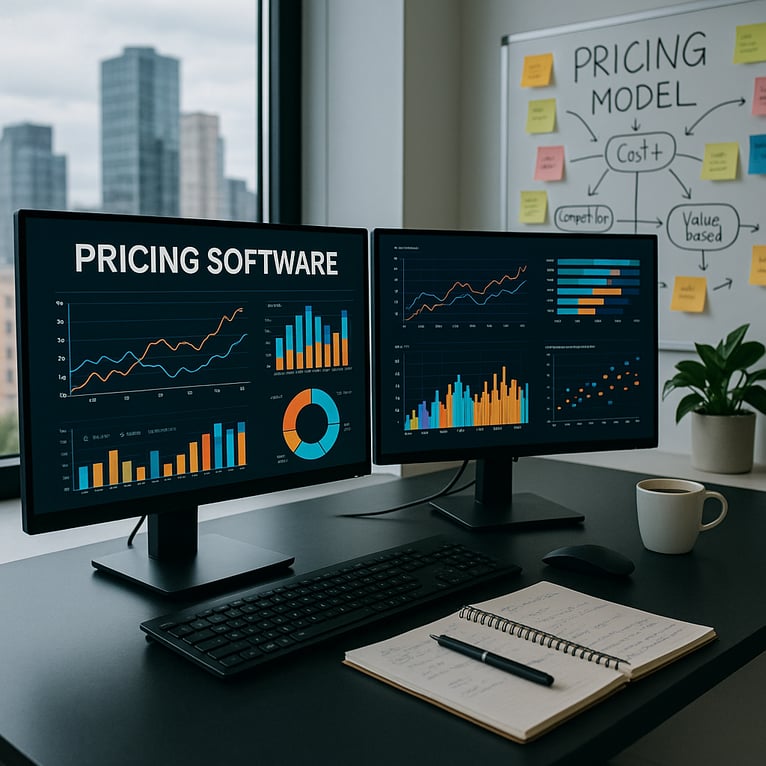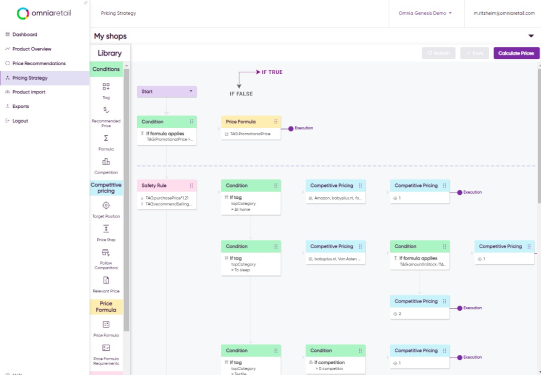Price skimming is a pricing strategy that can facilitate a higher return on early investments, influence the branding and appeal of a product, and allow a brand to target specific segments of a given market. This comprehensive guide will walk you through everything you need to know about implementing a successful skimming pricing strategy.
Brands use price skimming to optimize revenue and margin across the lifecycle of a product, skimming off market segments. Furthermore, it helps maintain a better ROI regarding research and product development. Customers who are most loyal or seek premium products are more likely to pay top price. The subsequent skimming allows lower price points to attract the rest of the market.
In this complete guide, you'll learn:
- What is price skimming and what does skimming price mean?
- How to develop a successful skimming pricing strategy
- Real-world examples of price skimming in action
- Price skimming vs penetration pricing comparison
- Complete analysis of advantages and disadvantages of price skimming
- Skimming marketing tactics and implementation strategies
- Best practices and common mistakes to avoid
What is Price Skimming? Understanding What Skimming Price Means
Price skimming is a pricing strategy often related to innovative and high-demand products. At its core, skimming price means starting with high initial prices and gradually reducing them over time to capture different market segments. Brands set a high price ceiling for new products due to market analysis and consumer demand, then systematically lower prices to "skim" successive layers of customers willing to pay less.
The fundamental principle behind price skimming involves recognizing that different customer segments have varying price sensitivities and willingness to pay. The top layer of loyal customers buy at high prices during initial launch periods. A retailer then pivots to accommodate new layers of consumers by slowly lowering the price over time. Retailers continue this skimming pricing strategy until prices level off at a sustainable base price point.
This approach differs from other pricing strategies because it deliberately targets the most price-insensitive customers first, maximizing revenue from each market segment before moving to the next. The strategy works particularly well for innovative products, luxury items, technology releases, and products with strong brand loyalty.
Samsung uses a classic price skimming strategy for its mobile phones. When customer demand is high due to a new Galaxy release, the price is set to attract maximum revenue from early adopters and brand enthusiasts. After the initial fervor and hype wanes, Samsung systematically adjusts price points to suit broader consumer segments in the market, eventually reaching price-sensitive customers who waited for lower prices.
Samsung initially leverages price skimming to capture market attention and share from main rivals like Apple. Their Galaxy phones are strategically priced to compete with iPhones while maximizing revenue from customers willing to pay premium prices for the latest technology.
Developing a Comprehensive Skimming Pricing Strategy
A successful skimming pricing strategy requires careful planning, market analysis, and systematic implementation. The strategy involves multiple phases, each targeting different customer segments with appropriate pricing levels.
Phase 1: Market Research and Customer Segmentation
Before implementing price skimming, companies must thoroughly understand their target market segments. This involves identifying customer groups based on price sensitivity, brand loyalty, income levels, and purchasing behavior. Early adopters and brand enthusiasts typically form the first segment, willing to pay premium prices for new products or exclusive access.
Market research should include competitor analysis, demand forecasting, and price elasticity studies. Understanding how customers respond to different price points helps determine optimal pricing tiers and timing for price reductions.
Phase 2: Initial High-Price Launch
The launch phase involves setting prices significantly higher than intended long-term levels. This initial high price serves multiple purposes: recovering research and development costs quickly, establishing premium brand perception, and maximizing revenue from customers with low price sensitivity.
During this phase, companies often limit supply to maintain exclusivity and justify high prices. Limited availability creates urgency and reinforces the premium positioning.
Phase 3: Systematic Price Reduction
As initial demand from premium segments is satisfied, companies gradually lower prices to attract price-sensitive customers. These reductions should be planned strategically, with specific timelines and price points determined in advance.
Each price reduction targets a new customer segment, expanding the potential market while maintaining profitability. The key is timing these reductions to maximize revenue from each segment before moving to the next.
Phase 4: Market Stabilization
Eventually, prices stabilize at competitive market levels. By this point, the product has captured revenue from all targeted segments, and ongoing pricing decisions focus on maintaining market position and profitability.
Nike exemplifies masterful implementation of skimming pricing strategy with its popular trainer releases. The company charges premium prices for new products and limited releases, targeting sneaker enthusiasts and collectors willing to pay top dollar for exclusive or innovative designs.
Brands at the top of their market like Nike have significant leverage in setting high initial prices. These premium prices are justified by strong demand for Nike trainers and exceptional brand loyalty. Months after a release, Nike systematically lowers prices to accommodate broader customer segments, including those who prefer to buy at sale prices.
The dynamic between online and offline sales adds complexity to Nike's strategy. The company must align in-store and online prices while considering the Ropo Effect (research online, purchase offline), which can drive additional in-store sales.
Real-World Examples of Price Skimming Success
Understanding price skimming through real-world examples helps illustrate how companies successfully implement this strategy across different industries and product categories.
Technology Industry: Apple's iPhone Strategy
Apple's iPhone launches represent textbook examples of price skimming. Each new iPhone model launches at premium prices, targeting early adopters and Apple enthusiasts willing to pay for the latest technology. Over the product lifecycle, Apple gradually reduces prices on older models while maintaining premium pricing on newest releases.
This strategy allows Apple to maximize revenue from different customer segments while maintaining its premium brand image. The company recovers massive research and development investments quickly through high initial prices, then captures broader market segments through subsequent price reductions.
Gaming Industry: PlayStation Console Launches
Sony's PlayStation console releases demonstrate long-term price skimming success. The PlayStation 5 launched at premium prices targeting gaming enthusiasts and early adopters. Historical data shows Sony consistently reduces console prices over time to capture broader gaming audiences.
Sony sold more PlayStation 4 consoles in years three and four after release than in the first two years. This pattern reflects successful price skimming, where initial high prices target core gamers, while subsequent price reductions attract mainstream consumers.
Fashion and Luxury: Limited Edition Releases
High-end fashion brands regularly employ price skimming for limited edition releases. Brands like Supreme, Off-White, and luxury sneaker collaborations launch products at extremely high prices, targeting collectors and fashion enthusiasts. These products often appreciate in value on secondary markets, reinforcing the effectiveness of initial high pricing.
Automotive Industry: Electric Vehicle Launches
Tesla pioneered price skimming in the electric vehicle market, launching high-end models like the Model S at premium prices before introducing more affordable options like the Model 3. This approach allowed Tesla to establish itself as a premium brand while gradually expanding market reach.
Pharmaceutical Industry: Patent-Protected Drugs
Pharmaceutical companies often use price skimming for new drugs during patent protection periods. Initial high prices help recover research and development costs, with prices typically declining when generic competitors enter the market after patent expiration.
(Source: https://camelcamelcamel.com/PlayStation-4-Console/product/B00BGA9WK2)

Price Skimming vs Penetration Pricing: A Detailed Comparison
Successful retailers remain agile regarding pricing strategy, as setting prices high or low can be equally advantageous depending on market conditions and business objectives. Price skimming and penetration pricing represent opposite approaches, each with distinct applications and benefits.
Understanding Penetration Pricing
Penetration pricing involves setting lower prices compared to market competitors. This strategy allows brands to gain rapid exposure in crowded markets, quickly acquiring market share by attracting price-sensitive consumers looking for value.
Penetration pricing helps attract new users, introduces brands to markets, competes directly with established leaders, and builds market share rapidly. Companies often pair this strategy with price monitoring software for optimal timing and performance tracking.
Key Differences in Application
Market Entry Approach: Price skimming targets premium segments first, while penetration pricing targets mass markets immediately. Skimming builds exclusivity; penetration builds accessibility.
Revenue Generation: Skimming maximizes short-term revenue per unit; penetration maximizes long-term volume and market share. Skimming prioritizes profit margins; penetration prioritizes market position.
Brand Positioning: Skimming establishes premium brand perception; penetration positions brands as value-oriented. Skimming creates exclusivity; penetration creates accessibility.
Customer Acquisition: Skimming acquires customers gradually across segments; penetration acquires customers rapidly from competitor brands. Skimming builds loyalty through exclusivity; penetration builds loyalty through value.
Choosing the Right Strategy
The choice between price skimming and penetration pricing depends on several factors:
Product Innovation: Highly innovative products with few substitutes favor skimming. Commodity products in competitive markets favor penetration.
Brand Strength: Established premium brands can employ skimming effectively. New brands or value brands often require penetration strategies.
Market Competition: Limited competition supports skimming; intense competition may require penetration pricing.
Customer Base: Markets with significant numbers of price-insensitive customers support skimming; price-sensitive markets favor penetration.
Related Reading: Why Price Is the Most Important P
Comprehensive Analysis: Advantages of Price Skimming
1 - Supply and Demand Optimization & ROI Maximization
Premier products necessitate significant preparation and substantial early investment. High price points combined with limited supply, exemplified by product launches like the PlayStation 5, help companies recuperate earlier investments rapidly and ensure superior ROI. As product availability increases over time, companies can strategically decrease prices as demand naturally decreases.
This approach provides several financial benefits: rapid cost recovery reduces financial risk, high margins fund continued innovation, and strong ROI justifies premium positioning. Companies can reinvest higher returns into research, development, and brand building activities.
Apple exemplifies this advantage through substantial technology and research investments. Premium iPhone pricing through price skimming allows Apple to reinvest higher returns back into the brand, strengthening its market position and funding continued innovation in areas like chip design, software development, and manufacturing processes.
2 - Premium Brand Image Development
Price skimming creates powerful psychological associations between high prices and premium quality. "Sneakerheads" may pay more than 10x retail price for popular trainers because ownership equals prestige, novelty, and exclusive access. Price skimming inspires consumer feelings and behaviors that actively sculpt brand image and market perception.
This strategy builds brand equity through perceived exclusivity, creates aspirational value for broader audiences, establishes premium positioning versus competitors, and generates organic marketing through status symbol appeal.
The Adidas Predator football boot demonstrates sustained brand image benefits. First introduced in 1994, the boot has maintained premium positioning through multiple iterations. The most recent Predator release continues commanding premium prices, demonstrating how consistent price skimming builds lasting brand value.
3 - Advanced Market Analysis and Customer Segmentation
Retailers celebrate price skimming because it naturally segments customers for deeper market analysis. The strategy allows marketers to segment customers into distinct groups based on price sensitivity, purchasing behavior, and brand loyalty. Analyzing what percentage of a market pays premium prices provides valuable insights for future product development and pricing strategies.
This segmentation reveals customer lifetime value across segments, identifies optimal price points for different groups, provides data for demand forecasting, and informs product development priorities based on segment preferences.
Sony's PlayStation strategy demonstrates sophisticated market analysis through price skimming. Early adopters and gaming enthusiasts gladly pay premium prices for new console releases. Historical data shows Sony consistently sold more PlayStation 4 consoles in years three and four than in the initial two years, indicating successful expansion into price-sensitive segments through strategic price reductions.
Sony's approach suggests careful analysis of gaming market trends combined with historical sales data to optimize pricing strategies across product lifecycles.
4 - Strategic Pricing Intelligence and Market Control
Price skimming serves as a crucial element within broader pricing strategies. Companies leverage skimming not only for ROI and market analysis but also to gain strategic intelligence about market dynamics, competitive responses, and customer behavior patterns.
This intelligence provides several strategic advantages: understanding price elasticity across market segments, testing market acceptance of premium positioning, gathering competitive response data, and informing long-term pricing policies.
Nike's Air Jordan launch illustrates this strategic dimension. Initially, Nike had modest sales expectations for the first Air Jordan trainers. At the time, paying hundreds of dollars for trainers was virtually unprecedented. The subsequent success created Nike's approach to premium athletic footwear marketing, establishing templates for limited releases, celebrity endorsements, and premium pricing strategies that continue generating billions in revenue.
5 - Revenue Stream Diversification
Price skimming enables companies to create multiple revenue streams from single products by targeting different market segments sequentially. This approach maximizes total revenue potential while building sustainable market presence across customer segments.
Revenue diversification benefits include: reduced dependence on single market segments, optimized revenue timing across product lifecycles, enhanced financial predictability through planned price reductions, and improved market coverage without cannibalizing premium sales.
6 - Competitive Advantage and Market Positioning
Successfully implemented price skimming creates significant competitive advantages by establishing market leadership, building barriers to entry, and creating customer loyalty across segments. Premium pricing signals quality and innovation, making it difficult for competitors to challenge market position.
Related Reading: Amazon Success Strategies
Complete Analysis: Disadvantages of Price Skimming
1 - Customer Relationship Risks and Pricing Objectives Conflicts
While price skimming recuperates early investments and creates product mystique, it can potentially alienate early adopters who feel penalized for their loyalty. Emotional appeal can help or hinder brand relationships depending on how companies manage price transitions.
Lowering prices of previously high-priced items may irritate early adopters who paid premium prices. This creates several relationship risks: early adopters may feel exploited, reduced exclusivity diminishes prestige value, customer trust may erode if price reductions seem premature, and negative word-of-mouth can damage brand reputation.
The 2007 iPhone price reduction from $599 to $399 within months of launch exemplifies these risks. Early adopters' anger was so intense that Steve Jobs issued a public apology and offered $100 Apple Store credit to mollify customers who felt "cheated." This incident highlights how poorly managed price reductions can damage customer relationships and brand reputation.
Companies must carefully balance short-term revenue goals with long-term customer relationship objectives. Consider announcing planned price reduction schedules upfront, offering exclusive benefits to early adopters, or providing upgrade paths that maintain customer loyalty.
2 - Market Reality and Implementation Limitations
Price skimming represents an incredibly powerful strategy, but only for companies offering genuinely high-demand products with strong brand positioning. Luxury brands like Gucci and Louis Vuitton command consistently high prices because they offer genuinely exclusive products with strong brand heritage and limited availability.
However, a major disadvantage involves implementation limitations: many brands lack sufficient market power to implement effective price skimming, products without clear differentiation cannot justify premium pricing, weak brand positioning undermines skimming effectiveness, and insufficient demand at premium prices makes the strategy unviable.
Companies considering price skimming must honestly assess their market position, brand strength, product differentiation, and customer demand patterns. Dynamic Pricing software can provide data necessary for realistic assessment and implementation decisions.
3 - Competitive Response and Market Dynamics
Price skimming decisions are inherently relative to competitive landscapes. Setting prices high can drive customers toward competitors, especially if alternative products offer comparable value at lower prices. Price changes rarely go unnoticed by competition, often triggering strategic responses that can undermine skimming effectiveness.
Competitive risks include: competitors may undercut prices to capture market share, alternative products may emerge targeting neglected price segments, competitive responses may force premature price reductions, and market share losses may offset revenue benefits from premium pricing.
Gaming console pricing illustrates these competitive dynamics:
Xbox and PlayStation pricing strategies are closely interconnected. Each company's pricing decisions directly influence competitor responses. Sony's pricing maneuvers are immediately analyzed and often countered by Microsoft, creating dynamic competitive environments where price skimming must account for competitive retaliation.
Utilizing tools like Pricewatch helps companies monitor competitive responses in real-time, enabling more informed decisions about pricing strategies and timing.
4 - Market Penetration Limitations
Price skimming inherently limits initial market penetration by excluding price-sensitive customers. This can create several strategic disadvantages: slower market share growth, reduced network effects for products benefiting from widespread adoption, limited economies of scale due to lower initial volumes, and potential market share losses to competitors using penetration pricing.
For products where network effects or viral adoption drive long-term success, price skimming may actually reduce total lifetime value by limiting initial user base growth.
5 - Timing and Execution Complexity
Successful price skimming requires sophisticated timing and execution. Companies must accurately predict demand patterns, competitive responses, and optimal price reduction schedules. Poor timing can lead to: premature price reductions that alienate early adopters, delayed price reductions that miss market opportunities, inconsistent messaging that confuses customers, and execution mistakes that damage brand credibility.
Skimming Marketing: Integration with Broader Marketing Strategies
Effective price skimming extends beyond pricing decisions to encompass comprehensive marketing strategies that support premium positioning and systematic market expansion. Skimming marketing involves coordinated efforts across all marketing channels to reinforce pricing strategy and maximize effectiveness.
Brand Positioning and Messaging Strategy
Skimming marketing begins with establishing premium brand positioning that justifies high initial prices. This involves developing messaging that emphasizes innovation, exclusivity, quality, and unique value propositions that differentiate products from competitors.
Effective positioning strategies include: highlighting technological innovations and unique features, emphasizing craftsmanship and premium materials, creating narratives around exclusivity and limited availability, and building aspirational brand associations that justify premium pricing.
Luxury brands excel at skimming marketing through consistent premium messaging. Brands like Rolex, Ferrari, and Hermès maintain premium positioning across decades through careful brand management and messaging strategies that support high prices regardless of market conditions.
Channel Strategy and Distribution Control
Skimming marketing requires careful channel management to maintain premium positioning and control price erosion. Companies must select distribution partners that align with premium brand image and can maintain pricing discipline across channels.
Channel considerations include: partnering with premium retailers that reinforce brand positioning, controlling online distribution to prevent unauthorized discounting, managing supply chain to maintain appropriate scarcity, and coordinating global distribution to prevent price arbitrage.
Customer Communication and Relationship Management
Managing customer relationships becomes crucial during price skimming implementation. Companies must communicate value clearly to justify premium prices while preparing customers for eventual price reductions without alienating early adopters.
Communication strategies include: transparent communication about value propositions, exclusive benefits for early adopters, clear communication about product lifecycles and pricing evolution, and loyalty programs that reward premium customers.
Digital Marketing and E-commerce Integration
Modern skimming marketing must integrate digital channels effectively. Online platforms provide opportunities for targeted marketing to specific customer segments while enabling sophisticated pricing strategies across different customer groups.
Digital integration involves: targeted advertising to price-insensitive customer segments, sophisticated email marketing campaigns that support premium positioning, social media strategies that build brand aspiration and exclusivity, and e-commerce platforms that support dynamic pricing strategies.
Best Practices for Implementing Price Skimming
Pre-Implementation Assessment
Before implementing price skimming, companies should conduct thorough market research to assess feasibility. This includes analyzing customer segments and price sensitivity, evaluating competitive landscape and potential responses, assessing brand strength and differentiation, and determining optimal pricing tiers and timing.
Strategic Planning and Timeline Development
Successful price skimming requires detailed strategic planning with specific timelines and milestones. Companies should develop clear pricing schedules with predetermined price points and timing, establish communication strategies for each pricing phase, create contingency plans for competitive responses, and define success metrics and monitoring systems.
Cross-Functional Coordination
Price skimming affects multiple business functions and requires coordinated execution across teams. Sales teams need training on value-based selling techniques, marketing teams must develop segment-specific campaigns, customer service teams require preparation for customer inquiries about pricing, and finance teams need systems for tracking revenue across segments.
Technology and Analytics Integration
Modern price skimming benefits significantly from technology integration. Companies should implement pricing analytics tools to monitor performance, competitive intelligence systems to track market responses, customer relationship management systems to maintain segment relationships, and dynamic pricing capabilities for optimal price adjustments.
Common Mistakes to Avoid in Price Skimming
Overestimating Market Demand
One common mistake involves overestimating demand at premium price points. Companies may set initial prices too high, assuming customer willingness to pay exceeds actual market reality. This can result in slower initial adoption, negative market feedback, and forced premature price reductions.
Poor Timing of Price Reductions
Timing price reductions incorrectly can alienate customers or miss market opportunities. Reducing prices too quickly may anger early adopters, while reducing prices too slowly may allow competitors to capture market share.
Inadequate Communication Strategy
Failing to communicate clearly with customers about pricing strategies and value propositions can create confusion and negative reactions. Companies must maintain consistent messaging that supports premium positioning while preparing markets for price evolution.
Ignoring Competitive Responses
Companies sometimes implement price skimming without adequately considering or monitoring competitive responses. Competitors may respond with alternative products, aggressive pricing, or marketing campaigns that undermine skimming effectiveness.
Measuring Success in Price Skimming Strategies
Effective price skimming requires comprehensive measurement and analysis to optimize performance and inform future strategies. Companies should track multiple metrics across different aspects of the strategy.
Financial Performance Metrics
Key financial metrics include: revenue per segment and total revenue optimization, profit margins across pricing phases, return on investment calculations, and customer lifetime value across segments. These metrics help assess whether price skimming is delivering expected financial benefits.
Market Performance Indicators
Market metrics include: market share evolution across pricing phases, customer acquisition rates by segment, brand perception and positioning metrics, and competitive response tracking. These indicators show how price skimming affects market position and competitive dynamics.
Customer Satisfaction and Loyalty Measures
Customer metrics include: satisfaction scores across pricing phases, customer retention and repeat purchase rates, net promoter scores by segment, and customer feedback regarding pricing and value perception. These measures help identify potential relationship risks and opportunities.
Future Trends in Price Skimming
Price skimming continues evolving with technological advances and changing market dynamics. Several trends are shaping the future of skimming strategies.
AI-Powered Dynamic Pricing
Artificial intelligence enables more sophisticated price skimming through real-time market analysis, automated price adjustments, predictive analytics for optimal timing, and personalized pricing strategies. AI allows companies to implement more precise and responsive skimming strategies.
Subscription and Service Integration
Companies increasingly combine product price skimming with service and subscription models. This approach enables ongoing revenue streams while maintaining premium positioning through value-added services and continuous innovation.
Global Market Considerations
Global markets require adapted price skimming strategies that account for different economic conditions, cultural preferences, competitive landscapes, and regulatory environments across regions.
Conclusion: Mastering Price Skimming for Business Success
Price skimming represents a powerful tool for retailers seeking to gain market share, maximize revenue, and build premium brand positioning. When combined with sophisticated pricing software, skimming strategies can be tremendously advantageous for companies with the right market conditions and execution capabilities.
Successful implementation requires understanding what skimming price means in practical terms: starting high and systematically reducing prices to capture different market segments. This approach helps companies recover greater returns on initial investments, position products to attract premium buyers, gain deeper insights into customer segmentation, and use data to inform future pricing strategies.
However, companies must also understand the disadvantages of price skimming, including potential customer relationship risks, implementation limitations, competitive response challenges, and execution complexity. Success requires careful planning, sophisticated execution, and ongoing monitoring of market dynamics.
The examples of price skimming across industries - from Apple's iPhone launches to Nike's sneaker releases - demonstrate how leading companies successfully implement these strategies. By understanding both advantages and disadvantages, developing comprehensive skimming marketing approaches, and following proven best practices, companies can leverage price skimming to achieve sustainable competitive advantages.
Ready to explore more pricing strategies? Check out our comprehensive guides below:
- What is Value Based Pricing?: A comprehensive overview of how price and consumer perception work together to create value.
- What is Charm Pricing?: An in-depth introduction to psychological pricing methods and their effectiveness.
- What is Penetration Pricing?: A complete guide on gaining market attention when entering new markets.
- What is Odd Even Pricing?: An detailed explanation of the psychology behind different numbers in pricing strategies.
- What is Bundle Pricing?: Comprehensive analysis of the benefits and implementation of bundle pricing strategies.
- What is Cost Plus Pricing?: Complete coverage of cost-plus pricing and strategic applications for different business contexts.
- Complete Guide to Psychological Pricing Strategies: Modern pricing psychology and three proven strategies for driving profits and building brands.
- How to Build a Comprehensive Pricing Strategy: A complete strategic guide on building effective pricing strategies from Omnia partner Johan Maessen, owner of Commercieel Verbeteren.



.png?height=766&name=Untitled%20design%20(21).png)

